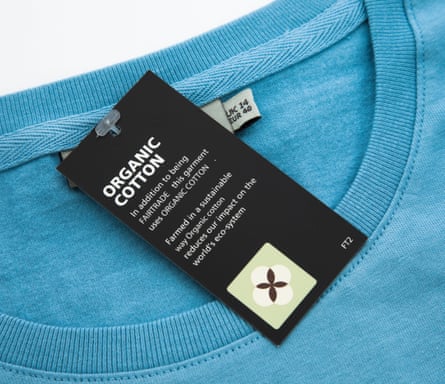
From the raw materials used, to the working conditions in the factory where it was made, to the number of times you wear it before throwing it away, a lot goes into determining whether a T-shirt is sustainable.
Unfortunately, the fashion industry is notoriously opaque about many of these factors. This problem is made worse by subcontracting between factories, and manufacturers buying reams of fabric made in far-away places without asking questions about the provenance of the materials. To make things even more confusing, as we discussed last week, the price of a T-shirt doesn’t necessarily guarantee that everyone along the supply chain has been treated well and paid fairly.
Of course, one way to avoid these issues is to only buy secondhand T-shirts made from natural fibres you will love, wear and repair for a really long time. But when the time you have to shop or what’s available in your size means this is not possible, there are things you can look out for when trying to buy a new T-shirt you can feel good about.
Transparency
Understanding how ethically made a product is means knowing exactly what has happened at each stage of production. But disclosing details including where the cotton in a T-shirt was grown or what type of energy was used in the factory that processed it is hardly commonplace.
Look for brands that are doing their best to explain what is happening all the way along their supply chains. Brands that provide information like where raw materials come from, their commitments to ensure workers are treated well and have been paid fairly, standards that indicate the safe use of chemicals, and what type of energy is used in production are a good place to start.
Very rarely information about where or how a product was made will be written on the swing tag. When it is not on the label, Julie Boulton, a sustainability strategist from the Monash Sustainable Development Institute, says these are things you should be able to find “on the brand’s website and in its reports”.
“Transparency in the supply chain is critical if change is to happen.”
When something you want to know isn’t listed anywhere, don’t be afraid to contact the brand directly to ask questions.
Certifications and accreditations
Certification and accreditation systems are not perfect but they are useful tools to ensure some standards are being met. Zoltan Csaki, the cofounder of Citizen Wolf, says to “look for reputable and stringent industry accreditation, such as Ethical Clothing Australia (ECA) or B-Corp certification”.
Courtney Holm, creative director of A.BCH, says: “ECA accreditation is one way to know the garment workers – who are skilled craftspeople – are being paid fairly and that operations meet Australian legal and Fair Work Australia requirements.” For items made offshore, she says to look for reputable social certifications such as Fair Trade or SA8000 (which covers social accountability).
These don’t guarantee best practices along the whole supply chain but some other standards to keep an eye out for are: Global Organic Textile Standard, Blue Sign and OEKO-TEX (which address responsible chemical usage), Responsible Wool Standard (which covers animal and land welfare), Global Recycle Standard and Forest Stewardship Council (which ensures products do not contribute to deforestation).
Location, location, location
The location of production or where the raw material was sourced from won’t tell you everything you need to know about the ethics at play, but they can be indicators.
For instance, a “Made in China” tag used to carry a lot of negative connotations but now, as the manufacturing capacity of the country has increased in both technology and expertise, it doesn’t necessarily mean a T-shirt is made in poor conditions or is of lower quality.
But a few years ago the Uyghur forced labour scandal broke, bringing an uncomfortable and sad spotlight to just how little we know about what goes on in the production of our clothes. “Chinese cotton from the Xinjiang region is cheap because of forced labour and modern slavery that is not properly priced in the final product,” Csaki says.
Further to this, Holm points out that “wages vary drastically from country to country”. A report by Baptist World Aid revealed that only 10% of clothing companies pay a living wage to factory workers in the final stage of their supply chain.
Buying T-shirts made in Australia from Australian cotton eliminates some of these uncertainties because, as Csaki says, Australia is “a country with strong labour laws and high minimum wages”.
What is the fabric made from?
Every material has an environmental cost but, generally speaking, a T-shirt made from 100% natural fibres will have a lower environmental impact in the long term.
To begin with, synthetic fabrics have to account for the “environmental destruction of extracting the oil from which they are derived”, Csaki says. They also shed microfibres when they are laundered, will not biodegrade and, since polyester and nylon are derived from oil, they hold on to body odour and stains, which compromise longevity.
T-shirts made from cotton-polyester blends should be avoided for similar reasons, and on top of this, given current technology, fibre blends are much harder to recycle than mono-materials.
Fortunately, fibre type is something you will find on a garment’s label.
Overproduction is a problem
Finally, if the fashion industry is going to curb its carbon footprint, it will have to reduce both production and consumption. “When it gets to the extremes as we see with fast fashion today, we need to pull things back,” Csaki says. “What’s the point of overproducing by 30% just so you can get a cheaper per-unit cost, when the result is landfill of unsold garments?”
Another way to change this is to look for garments produced “on demand”, Boulton says. “We have to be smarter about what we are producing and why.”



